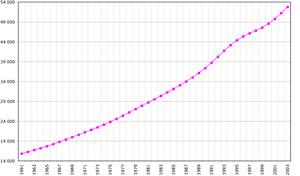Demographics of the Democratic Republic of the Congo
2007 Schools Wikipedia Selection. Related subjects: African Geography
The population of the Democratic Republic of the Congo was estimated at 46.7 million in 1997. As many as 250 ethnic groups have been distinguished and named. The most numerous people are the Bakongo, Luba, and Mongo. Although 700 local languages and dialects are spoken, the linguistic variety is bridged both by the use of French and the intermediary languages Kikongo, Tshiluba, Swahili, and Lingala.
About 80% of the Congolese population are Christian, predominantly Roman Catholic. Most of the non-Christians adhere to either traditional religions or syncretic sects. Traditional religions embody such concepts as monotheism, animism, vitalism, spirit and ancestor worship, witchcraft, and sorcery and vary widely among ethnic groups; none is formalized. The syncretic sects often merge Christianity with traditional beliefs and rituals. The most popular of these sects, Kimbanguism, was seen as a threat to the colonial regime and was banned by the Belgians. Kimbanguism, officially "the church of Christ on Earth by the prophet Simon Kimbangu," now has about 3 million members, primarily among the Bakongo of Bas-Congo and Kinshasa. In 1969, it was the first independent African church admitted to the World Council of Churches.
Before independence, education was largely in the hands of religious groups. The primary school system was well-developed at independence; however, the secondary school system was limited, and higher education was almost nonexistent in most regions of the country. The principal objective of this system was to train low-level administrators and clerks. Since independence, efforts have been made to increase access to education, and secondary and higher education have been made available to many more Congolese. Despite the deterioration of the state-run educational system in recent years, about 80% of the males and 65% of females, ages 6-11, were enrolled in a mixture of state- and church-run primary schools in 1996. At higher levels of education, males greatly outnumber females. The elite continues to send their children abroad to be educated, primarily in Western Europe.
Demographic data from the CIA World Factbook
Population
- 62,660,551
- Note: estimates for this country explicitly take into account the effects of excess mortality due to AIDS; this can result in lower life expectancy, higher infant mortality and death rates, lower population and growth rates, and changes in the distribution of population by age and sex than would otherwise be expected (July 2006 est.)
Age structure
- 0-14 years: 47.4% (male 14,906,488/female 14,798,210)
- 15-64 years: 50.1% (male 15,597,353/female 15,793,350)
- 65 years and over: 2.5% (male 632,143/female 933,007) (2006 est.)
- 15-64 years: 50.1% (male 15,597,353/female 15,793,350)
Population growth rate
- 3.07% (2006 est.)
Birth rate
- 43.69 births/1,000 population (2006 est.)
Death rate
- 13.27 deaths/1,000 population (2006 est.)
Net migration rate
- 0.25 migrant(s)/1,000 population
- note: fighting between the Congolese Government and Uganda- and Rwanda-backed Congolese rebels spawned a regional war in DRC in August 1998, which left 2.33 million Congolese internally displaced and caused 412,000 Congolese refugees to flee to surrounding countries (2006 est.)
Sex ratio
- At birth: 1.03 male(s)/female
- Under 15 years: 1.01 male(s)/female
- 15-64 years: 0.99 male(s)/female
- 65 years and over: 0.68 male(s)/female
- Total population: 0.99 male(s)/female (2006 est.)
- Under 15 years: 1.01 male(s)/female
Infant mortality rate
- Total: 88.62 deaths/1,000 live births
- Male: 96.9 deaths/1,000 live births
- Female: 80.1 deaths/1,000 live births (2006 est.)
- Male: 96.9 deaths/1,000 live births
Life expectancy at birth
- Total population: 51.46 years
- Male: 50.01 years
- Female: 52.94 years (2006 est.)
- Male: 50.01 years
Total fertility rate
- 6.45 children born/woman (2006 est.)
HIV/AIDS
- Adult prevalence rate: 4.2% (2003 est.)
- People living with HIV/AIDS: 1.1 million (2003 est.)
- Deaths: 100,000 (2003 est.)
- People living with HIV/AIDS: 1.1 million (2003 est.)
Major infectious diseases
- Degree of risk: very high
- Food or waterborne diseases: bacterial and protozoal diarrhea, hepatitis A, and typhoid fever
- Vectorborne diseases: malaria, plague, and African trypanosomiasis (sleeping sickness) are high risks in some locations
- Water contact disease: schistosomiasis (2005)
- Food or waterborne diseases: bacterial and protozoal diarrhea, hepatitis A, and typhoid fever
Nationality
- Noun: Congolese (singular and plural)
- Adjective: Congolese or Congo
Ethnic groups
- over 200 African ethnic groups of which the majority are Bantu; the four largest tribes - Mongo, Luba, Kongo (all Bantu), and the Mangbetu-Azande (Hamitic) make up about 45% of the population. Okay
Religions
- Roman Catholic 50%, Protestant 20%, Kimbanguist 10%, Muslim 10%, other syncretic sects and indigenous beliefs 10%
Languages
- French (official), Lingala (a lingua franca trade language), Kingwana (a dialect of Kiswahili or Swahili), Kikongo, Tshiluba
Literacy
- Definition: age 15 and over can read and write French, Lingala, Kingwana, or Tshiluba
- Total population: 65.5%
- Male: 76.2%
- Female: 55.1% (2003 est.)
- Total population: 65.5%
